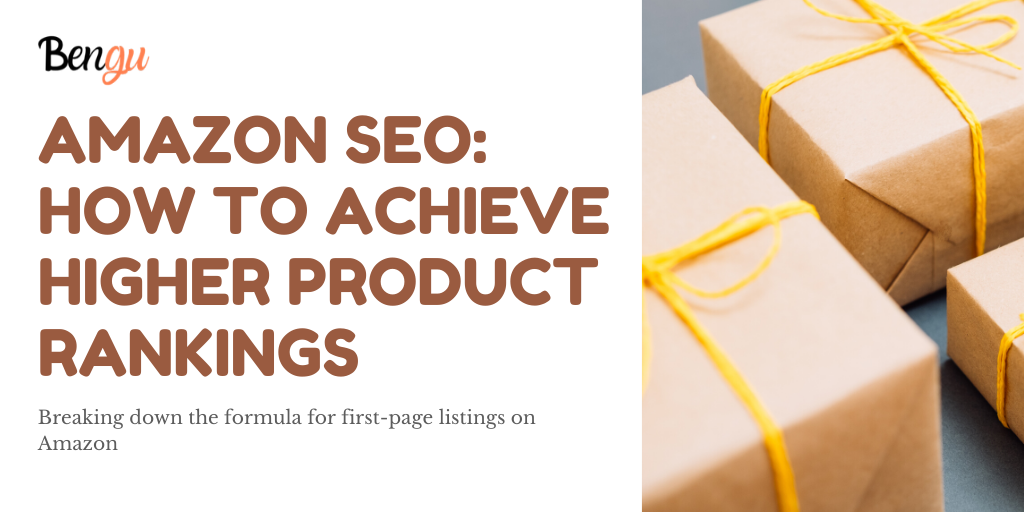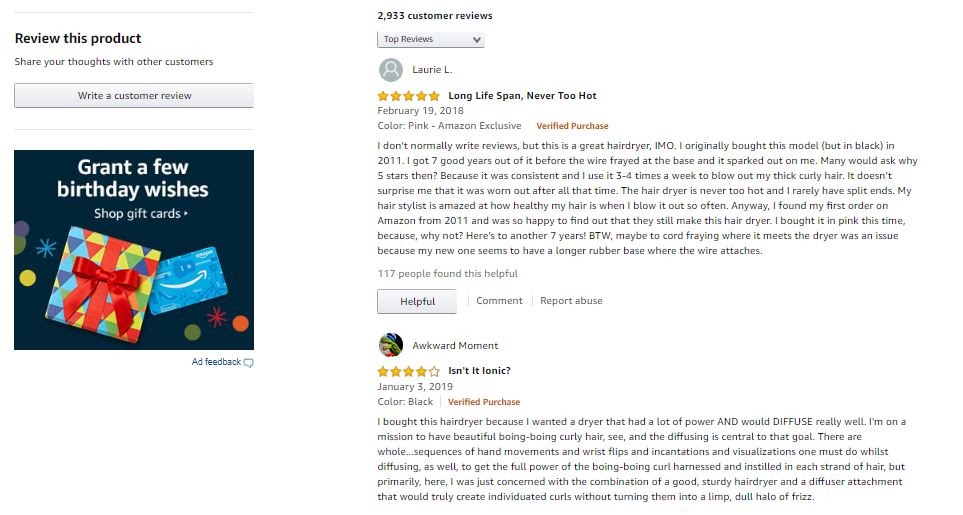The way we shop has changed forever. In 2019, Amazon Surpassed Walmart as the world’s largest retailer. But this is harder than it sounds:
Amazon sells 100s of millions of products every day in the US alone. On the one hand, this means there’s money to be made. On the other hand, it means the competition is stiff.
Enter Amazon SEO.
You might not think of Amazon as a search engine:
But just like Google, Amazon ranks products based on how well they meet users’ needs. The trick is to understand the ranking factors Amazon examines to determine rankings.
In this article, we’ll explore these parameters. We’ll also look at five strategies you can use to improve your search results. But first, let’s look at what Amazon SEO is all about.
What is Amazon SEO?
As the name suggests, Amazon SEO is the process of optimizing your product pages to perform better in search results.
The logic behind this is simple:
People are basically lazy, so the higher your products feature when someone searches Amazon, the more sales you’ll make. After all, how often do you slog through the third or fourth page of Amazon listings?
Ultimately, the formula is as simple as, more visibility equals more traffic, and more traffic equals more money.
Amazon’s A9 Algorithm
When you talk about SEO, you think backlinks, quality content and algorithms. For Amazon SEO, the name of the game is the A9 algorithm. Marketers aren’t always tech whizzes, so mentioning algorithms can sometimes scare them off.
Luckily, A9 is actually pretty simple:
Like Google’s algorithm, the A9 algorithm looks for several factors in product pages to determine the rankings in search results. Specifically, these four factors come into play:
- Textual relevance – This is how well the search query matches the textual elements of a listing, including the title as well as the body copy and even reviews,
- Availability – Amazon won’t rank your listing highly if it’s out of stock, or even if stock is likely to run out shortly.
- Price – Lower prices for the same product are prioritized,
- Performance – This is how popular your items are with other customers.
That’s the theory. Most people have a decent grasp of Google SEO, so let’s take a look at how Amazon SEO differs in practical terms.
What’s the difference between Amazon and Google SEO?
One obvious difference is that Amazon SEO is a level playing field in reference to certain ranking factors. For example, you don’t need to worry about the likes of site structure or loads speeds on Amazon.
Search intent doesn’t factor into Amazon SEO either. After all, if someone’s on Amazon in the first place, we can be pretty sure they want to make a purchase.
However, Amazon SEO still comes with its own challenges.
Of the factors we’ve looked at already, price and availability are pretty self-explanatory. It’s not rocket science to keep prices competitive and stock levels high.
The other two need a little more explanation:
For performance, the most important thing is how well a product sells. However, there are a few other things that come into play. Low return rates and good reviews also give a nice bump to your SEO.
Source: Ripen
The underlying logic of textual relevance isn’t that different from Google SEO. In fact, it’s still a game of targeting keywords in your titles and descriptions, though you don’t need to worry so much about the right anchor text.
With that in mind, let’s look at how to identify which keywords to build your Amazon SEO around.
Keyword Research
At the core of SEO is the keyword. These are the terms that users search for. Shoppers can only find your product on Amazon if your product page contains the keywords they entered into the search bar. This is why keyword research is essential.
Just like in Google SEO, keywords can be split into two groups. These are:
- Short-tail keywords — phrases of up to three words. They are often quite vague and receive high search volumes.
- Long-tail keywords — phrases of over three words. They are more specific and receive lower search volumes.
The most obvious keywords are specific brands or product names.
But apart from brainstorming, how can you identify these keywords? More importantly, how can you figure out which ones are worth targeting?
Let’s look at a couple of methods for keyword research:
Competitor Research
The easiest way to identify top-performing keywords is to spy on your competition. To do this, begin by searching for a generic term for one of your products
For example, if you want to sell hairdryers, begin by searching for ‘hairdryer’:
Radical stuff, I know!
We’re only interested in the top 10 organic listings. You can ignore any sponsored products. Your goal is to identify what these listings have in common.
Specifically, you’re looking for patterns in:
- The keywords they use in the title.
- Variations of the original search term in the title and throughout the copy.
- Modifiers to the original search term, in this case, words like ‘lightweight‘ and ‘high performance‘ placed before hairdryer.
Review Mining
Your competitors are not the only good source of keywords. Once you’ve checked out competitor listings, you can take a look at their product reviews. This is a useful strategy because it helps you find the exact keywords as customers use them. It’s especially helpful for identifying long-tail keywords.
This is what you will see after you click on the reviews icon of one of the top-ranking hairdryers being sold on Amazon:
Based on these reviews, here are some of the long-tails related to hairdryers which you could incorporate into your copy.
- Never too hot
- Great hairdryer
- Has a lot of power
- Diffuser attachment
Now that you have your initial list of keywords, you can use a tool like Longtail Pro, or another Amazon search tool, to refine it. This allows you to identify the search volume of each of your keywords on Amazon.
How to Achieve Higher Product Rankings on Amazon
Now that we know how to identify target keywords, let’s take a look at five concrete strategies you can adopt to improve your product rankings on Amazon.
Optimize Product Descriptions
Although it can be tempting to use the manufacturer’s content as your product description, don’t. You’ve gone to all the effort of researching your keywords. Why would you lift your copy off the shelf?
Additionally, manufacturers’ in-house copy is usually pretty wordy and hard to read.
To grab the attention of consumers, create compelling copy for your product description. And don’t forget to tell consumers about the benefits and functionality of your product.
If you don’t have a trademark for your product, enrol in the Amazon Brand Registry to use Enhanced Body Content. This will allow you to add images and customize your product description to make it more attractive.
If you don’t enrol, you will have to make do with Amazon’s text-only description, and that’s not very enticing, is it?
Use Long-tail Keywords in Titles
The title of your product is one of the most crucial elements of your product page. After all, this is the first thing users see. It should not turn people off.
For better results, use long-tail keywords in the title. Long-tails account for a majority of shopper’s searchers. If you’ve followed the steps above, you should already have a decent list of these.
Amazon recommends that your title is up to 60 characters. Include the brand and the product name, as well as more generic terms and specific things like the colour and size.
Obviously, your titles also need to be appropriately formatted. For instance, use title case and not all caps since this may turn people off.
Here’s an example of a good product title. This product ranks among the top in Amazon search results for hair dryers:
Only Use Unique Content
This is a no-brainer. In general, people are more compelled by unique content than to content that is “mass-produced”.
This is another reason why you shouldn’t use the manufacturer’s content as your product description. Most of your competitors are probably taking this short cut.
By using unique, compelling copy, you’ll work up a better conversion rate. In turn, this will help you climb the search rankings as your sales increase.
The use of unique content also helps establish a good reputation. This is because if a shopper sees you took the time to write that content for your product, they’ll know that you’re a professional operation.
Building trust helps to encourage sales.
Optimise Product Images
For Amazon SEO, images are just as important as your sales copy.
It’s only natural for shoppers to want to see the product they are thinking of buying. After all, it’s the only way they can be sure the product contains the details and features they’re looking for.
To ensure better results, include at least five images of at least 1000 pixels in height or width of your product.
The pictures should highlight the features you specified in the product description.
Make sure the pictures have good lighting and that the products in them are easily recognisable. Again, this projects professionalism.
The more pictures you have of the product, the better.
You should also include your most important keywords in the meta-descriptions of your images.
Answer Customer Queries
Answering customer queries is good customer service. When you reply immediately to a question from a potential customer, you can build a relationship with them. This is especially important if you sell Private Label Products.
Besides, the additional content you and your potential customers create through those questions will help improve your rankings on Amazon.
It will even make you visible on other search engines (though the main aim is to get those Amazon rankings).
If you answer someone’s query about your product, that person is more likely to buy from you.
Additionally, the A9 algorithm will spot that you’re an active seller, who takes the time to engage with their customers. This improves the performance element of your SEO, as Amazon assumes that if you answer queries, you’ll also take care of other after-sales issues.
Amazon SEO – Recap
Amazon SEO is often ignored. Many marketers simply don’t realise that they need to treat Amazon like any other search engine. Failure to do this leads to poor sales figures and missed opportunities.
Luckily, Amazon SEO isn’t actually that complicated. Beyond ensuring low prices and high stock, it basically comes down to finding and targeting the right keywords in your product listings.
Amazon SEO can also be improved by boosting the performance of your listings. This is largely to do with making sales, but it can also be supplanted with good reviews and actively answering customers’ queries.
Nico is an online marketer and the founder of Launch Space. He’s a SaaS consultant and works with companies like Voila Norbert, an email verification tool. He’s worked with everyone from Fortune 500 companies to startups. Follow him on Twitter @nhdprins.














Great content! Super high-quality! Keep it up! :)